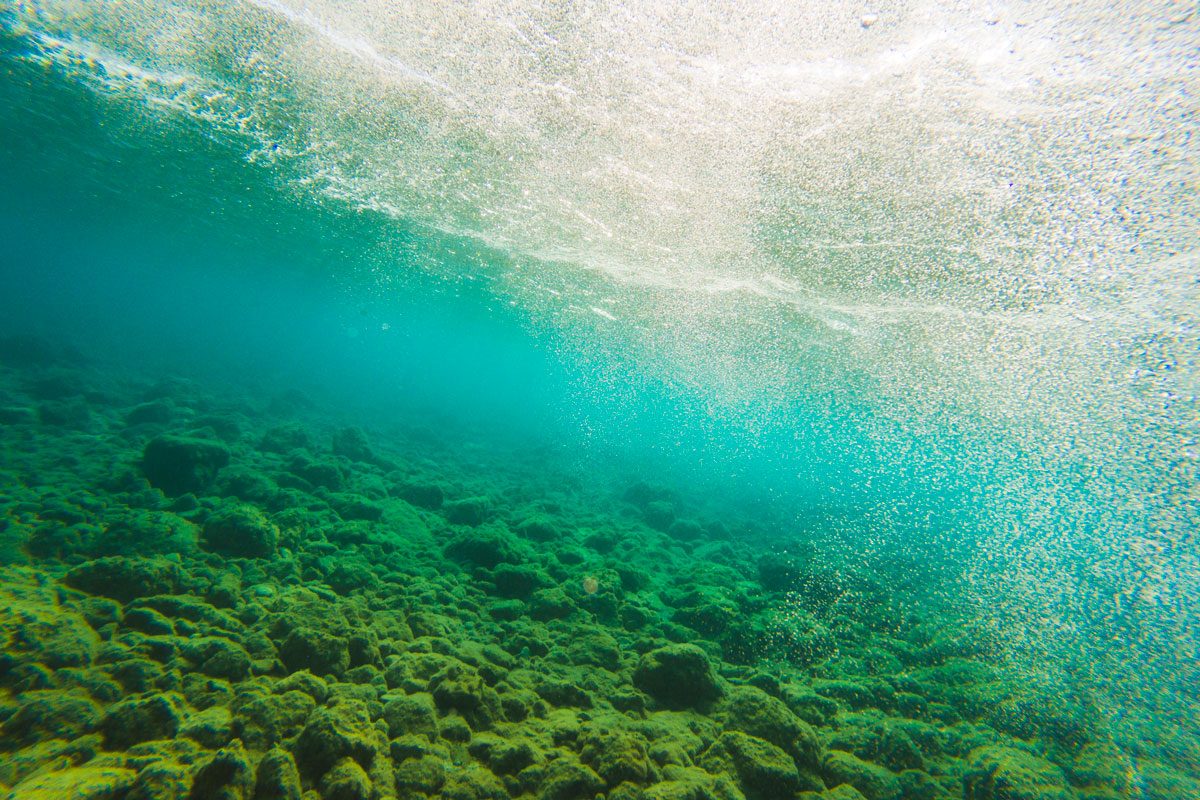It's weird, all right. We found out what's going on.

It’s Not Your Imagination: The Ocean Is Getting Greener—Here’s Why

You go on a beach trip or look out the airplane window, and you do a double take. You could swear the ocean is looking a bit teal. Are you imagining things, or is the ocean getting greener?
It is, in fact, turning a bit green, according to a recent study in the journal Nature. What’s going on? It’s not a toxic glow, is it? Like that episode of The Simpsons with the freaky three-eyed fish? We seriously hope not, but we definitely wanted to get to the bottom of this ocean mystery, preferably before our next ocean dip or seafood order.
Reader’s Digest dove into the research and spoke with conservation scientist Chris Robbins, associate director of science at the Ocean Conservancy, to find out what this green shift means for our health … and the planet’s too.
Get Reader’s Digest’s Read Up newsletter for more interesting facts, humor, cleaning, travel and tech all week long.
Why is the ocean getting greener?

The ocean is getting greener because there is more phytoplankton (aka microscopic algae) in the ocean’s uppermost layer. It appears green because phytoplankton “contain the pigment chlorophyll that absorbs blue and red light,” says Robbins.
What’s more, over the past 20 years, there has been a significant greening of the oceans, according to the Nature study. The likely culprit is greenhouse gas emissions. “Emissions are heating up the ocean, resulting in a sharper temperature differential that is stratifying the ocean into a shallower warm layer and deeper cold layer,” Robbins explains. As the ocean warms, a colder, saltier layer forms below a warmer, less salty layer. Called stratification, “it prevents the transfer of nutrients from the colder ocean depths to warmer surface waters where phytoplankton live,” he explains. Having fewer nutrients could favor phytoplankton species, meaning they congregate at the surface and make the ocean appear greener.
How much of the ocean has been affected?
The study found that 41% of the ocean has had a color change in the past 20 years. That’s a big swath of waterways, though the tilt is most pronounced in the oceans by the equator—right by many of the best tropical beach destinations, incidentally.
Is this dangerous to humans?

Good news for your summer plans: This greening isn’t hazardous to people. “There is no indication that the increases in phytoplankton species causing the greening effect are harmful,” Robbins says.
Now for the not-so-hot part: These changes in ocean conditions are leading to a rise in harmful algal blooms (HABs) like “red tide” in the United States and globally. So that’s not a good thing—and that is super dangerous.
Is a greener ocean harmful to marine life?
Scientists are still trying to figure out what this green trend might mean for fish and other sea life. “It could hurt some species while benefitting others,” Robbins says. What is known: The green tilt is a sign that the ecosystem is changing in ways that could alter the food web (the food relationships within an ecosystem—a science fact you probably remember from biology class).
As it turns out, the greening isn’t just a sign of more phytoplankton, but it also suggests an increase in certain types of algae. Some algae could replace others, because ocean conditions now favor them. “If the newly dominant algae cannot be eaten by animals that rely on algae for food, there could be ripple effects, with some species losing and some winning,” Robbins says. “It could reorganize predator-prey dynamics.”
Will this affect our fish and seafood?
If certain in-demand fish don’t fare well in this new Hunger Games scenario, it could mean a seafood shortage. That would likely hurt the fish and seafood industries and might even affect what you can find at a local supermarket or seafood restaurant.
How worried are scientists, exactly?
The experts are pretty darn worried. “Scientists are concerned that the greening trend is caused by greenhouse gas emissions, which are altering ocean chemistry, physics and biology,” Robbins says. These changes pose a threat to our oceans because they cause low levels of oxygen, which is essential for marine life. “As phytoplankton die and decompose, oxygen in the water is used, leaving some areas with too little oxygen to support marine life,” Robbins explains. That, of course, means some creatures could die off, potentially causing a dangerous ripple effect.
Since the ocean color is so telling, scientists are keeping a super close eye on it. They’re doing that with an assist from satellites. In 2024, NASA launched the new PACE (Plankton, Aerosol, Cloud, Ocean Ecosystem) satellite, with a special Ocean Color Instrument (OCI) that can track ocean color changes in more detail. “The satellites use sensors to routinely monitor changes in ocean color based on factors like reflectance and chlorophyll,” Robbins explains. Reflectance is the amount of light the ocean reflects upward relative to the amount of sunlight the ocean absorbs. “Changes in reflectance over decades can tell scientists which ocean properties are changing and how those changes might impact ecosystem function and health.”
Is there any way to reverse this trend?
If we want to reverse the shift and the changes in the ocean’s ecosystem, we need to focus on replacing fossil fuels with clean energy, Robbins says. In addition, scientists are working to pinpoint the exact changes in the ocean. As the investigators note, ongoing studies could shed more light on what else is going on under the sea and how it will ultimately impact all of us.
About the expert
|
Why trust us
At Reader’s Digest, we’re committed to producing high-quality content by writers with expertise and experience in their field in consultation with relevant, qualified experts. We rely on reputable primary sources, including government and professional organizations and academic institutions as well as our writers’ personal experiences where appropriate. For this piece on why the ocean is getting greener, Lisa Lombardi tapped her experience as a longtime health and science reporter. We verify all facts and data, back them with credible sourcing and revisit them over time to ensure they remain accurate and up to date. Read more about our team, our contributors and our editorial policies.
Sources:
- Chris Robbins, associate director of science at the Ocean Conservancy; interviewed, March 2025
- Nature: “Global climate-change trends detected in indicators of ocean ecology”
- MIT: “Study: The ocean’s color is changing as a consequence of climate change”
- NASA: “Climate Change Lends New Color to the Ocean”
- NASA: “PACE Ocean Color Instrument”



